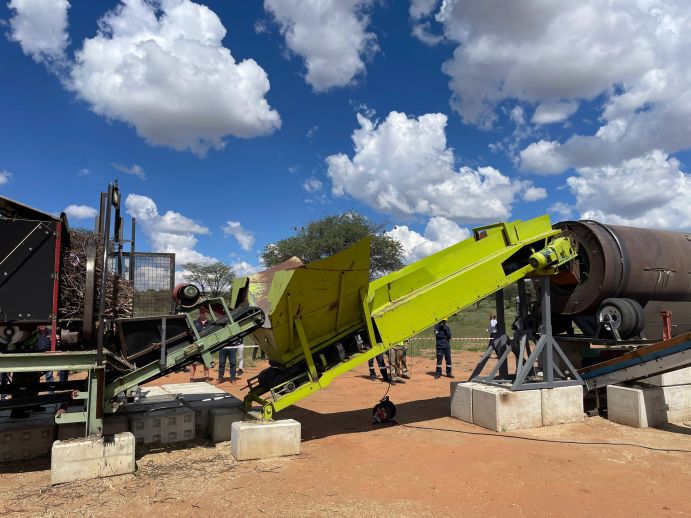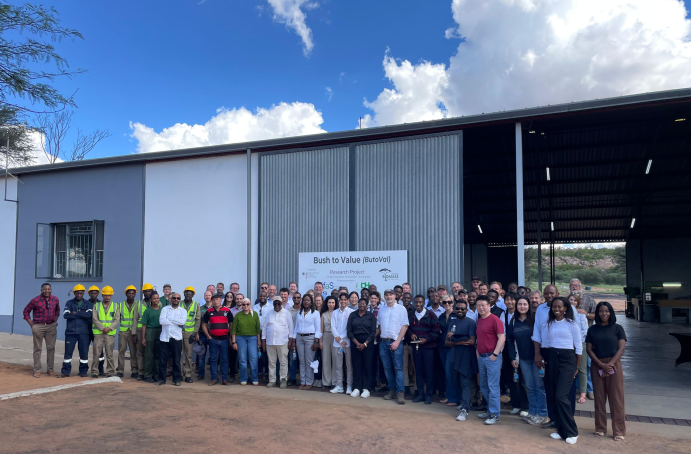BMBF project ButoVal: A new plant for processing bush biomass will help to restore savannahs in Namibia
The agricultural output of Namibia's savannahs has shrunk by two thirds in recent decades. The reason: bush encroachment on the grasslands. The BMBF project ButoVal has now presented a plant, that can effectively process bush biomass.

Agriculture in Namibia is facing major challenges: In recent decades, the agricultural productivity of the savannahs has fallen by two thirds. This is due to the loss of grazing land in the savannahs, which is used for livestock farming. The savannahs are currently heavily affected by so-called bush encroachment. Bush encroachment is the excessive spread of woody plants on grassland, which displaces the basic vegetation for livestock farming, such as grasses, and results in the loss of both fodder and grazing land. Scrub encroachment also reduces the food base for wild animals. The causes of scrub encroachment are overgrazing, the prevention of large-scale animal movements by fences and the suppression of field fires. Bush encroachment now affects around 45 million hectares of land in Namibia alone.
The consequences of bush encroachment: crop failures, economic damage and social problems
This bush encroachment leads to enormous economic damage and social challenges. This is because low-income landowners and tenants of communal land are particularly affected by the agricultural challenges and their livelihoods are jeopardised. In addition to the economic dimension, bush encroachment also poses a problem for biodiversity and Namibia's increasingly dwindling water supply. The bushes - which are usually very thorny - are displacing the natural habitat. Among other things, scrub encroachment exposes the cheetah to a high risk of injury during hunting and thus restricts its distribution. Conservation efforts for this species are therefore focussed on restoring open savannah.
Technical solutions have so far faced major challenges
So far, however, there has been no sustainable, technically and economically feasible solution to curb Namibia's bush encroachment and fully utilise the cleared bush biomass. Herbicides to control shrubs (arboricides) are sometimes used – with limited success – to slow down the spread of the bushes. The harvesting methods used to date for these bushes only utilise part of the removed shrubs and leave branches with thorns on the area, but this prevents the newly emerging grass from being used as cattle feed.
Due to the extreme conditions in the Namibian savannahs, complete and economical utilisation of the material resulting from bush clearing is technically extremely challenging: the bushes have particularly hard wood. Dust and heat, in turn, reduce the operational readiness of the machines by up to 70 per cent. There is also a lack of local maintenance facilities.
ButoVal with an innovative solution: harvesting and processing plant adapted to the savannahs for the production of recyclable biomass
The ButoVal ('Bush to Value') project, funded by the German Federal Ministry of Education and Research (BMBF), has now unveiled a new plant in Witvlei, 150 kilometres east of Windhoek. The inauguration event took place on 11 March 2025 with more than 100 participants, including the regional governor of Omaheke, Pijoo Nganate, and numerous stakeholders from the biomass industry.
The new bushwood utilisation plant processes bundled bales of prunings by shredding, debarking and sorting, thus preparing the material for further processing steps. Possible downstream products from this biomass include biochar and charcoal, wood pellets, wood chips or biodiesel. In this way, sustainably usable resources can be obtained. For rural regions in particular, the production of bush biomass means opportunities for energy supply, labour, education and development. In addition, once the bushes have been cleared, the land can be used again as pasture and fodder. In this way, local agriculture benefits in several ways.
The test systems allow real operation, but are not yet finally adjusted, but rather adaptable and thus provide the data basis for the economic and technical feasibility as a starting point for commercialisation. In the coming months, the project will therefore continue to optimise the system at all points in the production chain - from harvesting and packaging to approaches to product marketing.
The BMBF is funding the ButoVal project with around 1.8 million euros over a project period of three years from 2023 to 2026.
Key data on the butoval project
- Duration: 01.04.2023 – 31.03.2026
- Funding volume: 1.8 million euros
- Coordinator: Trier University of Applied Sciences, Environmental Campus Birkenfeld, Institute for Applied Material Flow Management (IfaS)
Project partners:
Germany:
- Dienstleistungs- und Consulting mbH (DHG), HAAS Holzzerkleinerungs- und Fördertechnik GmbH (Haas), CLAAS Global Sales GmbH (Claas), Amandus Kahl GmbH & Co. KG (Kahl)
Namibia:
Namibia University of Science and Technologie (NUST), lokaler Biomasseindustrieverband (NBiG), Namibia Nature Foundation (NNF), Charcoal Association of Namibia (CAoN)
For more information, see the project homepage: https://bmbf-client.de/projekte/butoval




